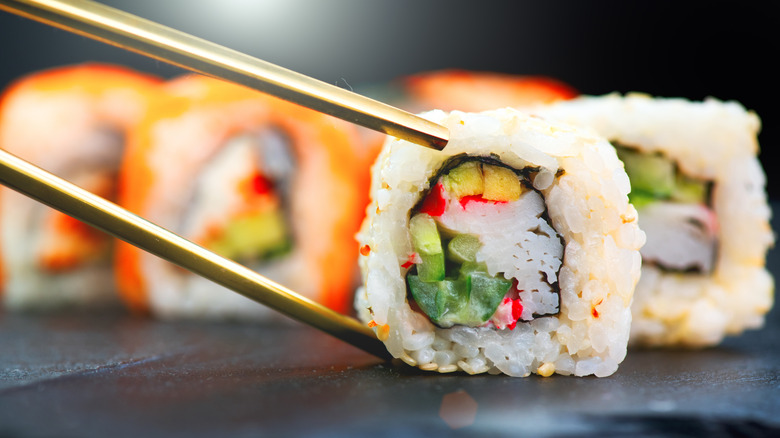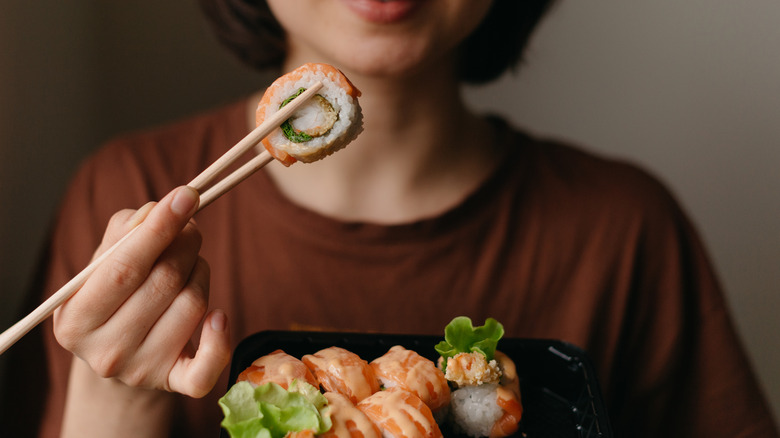Why You May Want To Add More Masago To Your Diet
Masago is the roe (or eggs) of the capelin fish — a small, herring-like fish found in the North Atlantic and Arctic oceans. According to Healthline, masago is commonly used as a sushi topping and in various types of Asian cuisine. The roe of the capelin fish is typically orange in color and has a slightly bitter flavor, with a more sandy than crunchy texture. This makes it a popular topping for sushi rolls and other dishes (via Medical News Today).
According to the source, Masago is also sometimes confused with tobiko. Although being another type of fish roe, it comes from different fish and has some differences in taste, texture, and appearance. Tobiko is the roe of the flying fish. It is typically red in color and is less bitter than masago. The latter is mostly used as a garnish rather than being a structured part of a meal.
In sushi, masago is often combined with other ingredients like cucumber to make a masago roll (via Izzy Cooking). Due to its small size, it can be used to decorate various types of sushi rolls. The small orange eggs can often be found scattered over a California Roll.
Why you may want to add more masago to your diet
According to Healthline, masago is a good source of protein, which is important for building and repairing tissues in the body. It can also help to maintain a healthy weight. According to a 2014 study published in the journal Nutrition and Metabolism, a high-protein diet might help reduce body fat. Another 2019 study published in the journal Nutrients states that protein is also essential for supporting healthy muscle mass, muscle repair, and growth.
Our muscles are made up of protein fibers, according to the Cleveland Clinic. When these fibers are damaged through exercise or injury, they need to be repaired and rebuilt. Protein is the primary nutrient that helps to facilitate this process (via Medical News Today). When you consume protein, it is broken down into individual amino acids, which are then used by the body to repair and build muscle tissue. The body can't produce some of the amino acids found in protein, which must be obtained through diet.
In addition to being rich in protein, masago is also low in calories and fat. According to WebMD, a 14-gram serving of masago contains about 20 calories and 1 gram of fat. This makes masago a good addition to a weight-loss diet.
Other nutritional benefits of masago
Besides its high protein content and low calories, masago has various other health benefits. According to Healthline, it's rich in omega-3 fatty acids, which are essential for heart health. Omega-3s can help lower the risk of heart disease by reducing inflammation, decreasing blood triglycerides (a type of fat), and lowering blood pressure (via Harvard T.H. Chan). WebMD cites masago as a good source of vitamins and minerals, such as vitamin D, which is important for bone health and the prevention of osteoporosis. Vitamin D also helps the body absorb calcium, which is necessary for strong bones and teeth, per the NIH Osteoporosis and Related Bone Diseases.
Another important nutrient found in masago is vitamin B12, which is essential for maintaining healthy nerve cells and red blood cells. This particular nutrient is difficult to obtain from vegetarian diets, according to a 2008 study published in the journal Canadian Family Physician.
It's worth noting that masago can be high in sodium, so it's important to consume it in moderation. High sodium can increase blood pressure (via Healthline). Also, people with seafood allergies or those on a restricted-sodium diet should avoid eating masago. It is important to consult with a healthcare professional before making any dietary changes.



